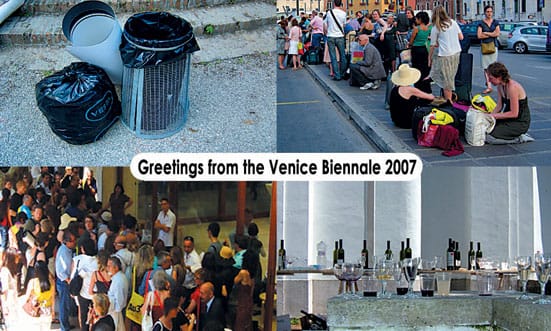The opening of the Venice Biennale is like Glastonbury for the over
25s, with the same concerns about blagging a pass or sneaking through
the hole in the fence behind the British Pavilion. This year the
biennale went a cool 3.5 million euros over budget with not a lot to
show for the extra expense. The Arsenale was a huge shed of trite war
schlock, painting and drawing. The highlights were the photos of
decorated New York gravestones by Jan Christian Braun and the African
Pavilion. An existing collection rather than this year's selected
artists, it was well laid out and had some very strong work, including
pieces by Basquiat, Ofili and Warhol, cited as being from the U.S.A.,
Britain/Nigeria and the U.S.A. respectively. Who shows where? What are
the criteria? Is it like playing in the World Cup or for Chelsea? Is
this going to cause problems for The New Forest Pavilion? These artists
raise questions about nationality and origin and an African Pavilion
raises other obvious questions like who gets one and why. China at the
end of the block have managed to acquire a permanent space but have yet
to show anything that can hold its own against the rows of huge oil
silos inside it. A square metre of marble in the Hong Kong Pavilion was
to be moved there later in the weekend to celebrate the anniversary of
the power transfer. Neither Tibet nor Taiwan are expected to extend
this symbolic action.
Over at the Italian Pavilion there are more dull squares of paint. Even
Kara Walker failed to excite: transforming her exquisite colonial
cut-outs into a film that was all a bit obvious. Bruce Nauman's
fountains had water gushing from the lips of a cast face, pouring
gallon after gallon of liquid down the invisible gullet. Sophie Calle's
mum was there in spirit. She died after the invitation to show was
received so a film of her while she was still alive is shown in the
space.
The Irelands, Northern and Eire (sharing a building for a positive
message) the Welsh and the Scottish all had their parties on the same
night (a rather less positive message).The rumours were flying. 'X is
full, Y is over, and Z is out of booze'. Scotland was Z, running out of
prosecco by 10.30 with a bland show and worse canapés. Circles of white
bread are poor and typical fare; if they're going to be crap make them
yours. What about little bits of deep fried mars bar on sticks?
Pavilions come and go. Afghanistan aren't there this year and
the Manchester Pavilion never showed up but that's just a neon sign in
a bar anyway. Sheffield was an A5 book and even New Zealand decided it
would look better on paper. France didn't but should have done. More
Calle, this time a letter from her ex analysed and interpreted by women
working in different fields. It was an intimate experience that would
have worked better in print than in a huge room full of people. Germany
kept the crowd outside in a huge queue and let people dribble in one by
one. It wasn't necessary and smacked of the pointless London clubbing
hype of the 1990s. Their party with the Scissor Sisters playing was
easier to get into and visually more interesting, playing in an
aerodrome that looked like an Ed Rusha painting.
There was a lot of neon kicking about this year and the nu-rave
aesthetic could be seen all over. Taiwan did it best with day-glo
water, U.V. lights and inflating cones. A lot of other work seemed to
use the technology just because it was there. Early 1980s computer
graphics continued the retro look and here AES+F's three-screen
animation in the Russian Pavilion of children with guns and trains and
lorries slowly crashing came out on top.
Estonia was showing the work of Marko Mäetamm and his lo-fi films in
which he murders his entire family but that aside there was little fun
to be had. The whole biennale felt staid and commercial with no
performance, no fanfare and not half enough foolishness, understandable
for an art-fair but not here. David Altmejd over in Canada bucked the
trend with a glitzy, exuberant show with mirrors, sad, stuffed animals
with unusual genitals and gold chain. Holland was showing the
brilliant, ambiguous films of Aernout Mik. Like a half-arsed
reconstruction of a martial law training exercise the actors wrestle
each other, bark orders, play air guitar and eat sandwiches. Korea was
showing the quasi-archaeological skeletons of cartoon figures, Bugs
Bunny et al produced by Hyungkoo Lee and his attempts to come to terms
with 'undersized Asian male complex'.
Nothing demonstrated how old fashioned the event was than the
American Pavilion this year. Rather than take a chance and try for
something lively and exciting with a living artist they plumped for the
safety of Felix Gonzalez Torres, oh how the climate has changed. Giving
away reams and reams of free posters may once have been utopian and
democratic it now highlights the extreme wastefulness of the event.
Every bin contains a poster or two, the billion cups for free water are
all plastic and unrecycled, every pavilion gives another ream of paper,
another book, another bag. Now maybe we can accept the tradition of the
national pavilions but if there is one place in the world that should
be sorting out the environmental end of the event it should be Venice.
AL

Welcome to the Venice Biennale 2007
Photogaphs by Adrian Lee and Nick Ferguson
2007